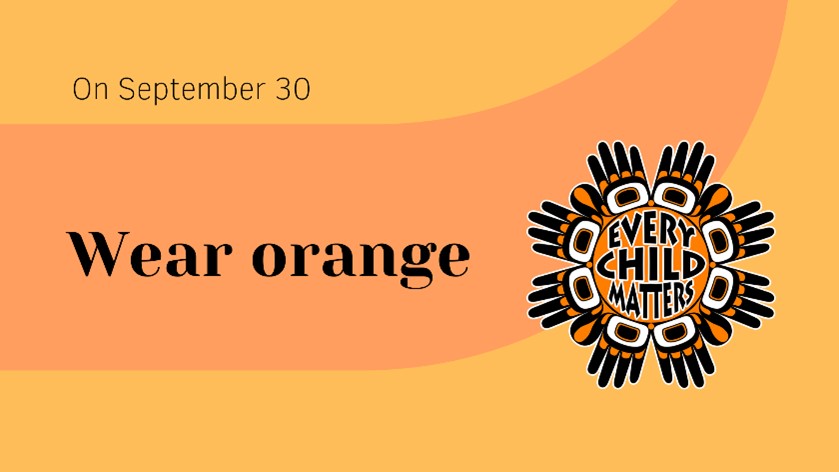This article originally appeared in the September 2021 issue of the Vista Virtual School newsletter.
If there was ever a year to wear orange on September 30, then this is it. 2021 has been a truly harrowing year for the survivors of Canada’s residential school system and their families—and for Indigenous Canadians generally—starting in May of this year with the discovery of the remains of at least 215 children in unmarked graves at the site of the Kamloops Indian Residential School in British Columbia, followed by subsequent discoveries of similar graves in Saskatchewan.
For millions of Canadians, these grisly discoveries were a sobering reminder that, a full five years after the dissolution of Canada’s Truth and Reconciliation Commission and the tabling of the TRC’s calls to action, the healing process surrounding this dark chapter of Canadian history has barely begun.
This week we mark National Day for Truth and Reconciliation (a.k.a. Orange Shirt Day) on Thursday, September 30, for which we encourage everyone to wear the colour orange out of respect for Canada’s residential school survivors and to engage in dialogue—as classes, families, workplaces etc.—about reconciliation and the road ahead for us as a society.
Residential School Facts at a Glance
A recent poll showed that half of Albertans know “little” about the residential school system, while a full 20 percent claim to know “nothing at all” about it. This fact in mind, it is worthwhile revisiting some of the key facts about this chapter of our history as a reminder of why it remains such a consequential issue.
- The residential school system operated for nearly 150 years, from 1863 until the last school closed in 1997.
- The schools operated in every province and territory except for New Brunswick and Prince Edward Island.
- More than 150,000 Indigenous children were taken from their families and placed in these schools. Schools were typically situated in very remote locations so as to discourage parental visits.
- Attendance was compulsory and enforced for Indigenous children aged seven to 16 from 1894 until 1948; thereafter financial incentives remained in place to coerce parents into continuing to have their students attend.
- Student deaths ranged between at least 3,201 (the official TRC count) and as many as 6,000 (according to some estimates), giving residential school students a higher mortality rate than Canada’s fighting forces in World War II. In the vast majority of cases, parents were not informed of their children’s deaths.
- Tuberculosis, a disease correlated with malnutrition and poor protection from the elements, was the primary killer of children at these schools. An Alberta physician in the 1920s on an inspection of a school in what is now Maskwacis, AB reported that at least 50 percent of children were afflicted with the disease.
- At least 90 percent of students were subjected to some sort of physical, emotional or sexual abuse. Corporal punishment was standard practice to deter children from speaking their native languages or practicing Indigenous customs.
- In some cases, students were subjected to medical experiments without their consent (or that of their parents). These included vaccine trials and even nutritional experiments, in which children were deliberately starved.
- The TRC estimates that some 80,000 survivors of residential school system remain, many of whom continue to suffer from wide-ranging emotional trauma.
- The Canadian government formally apologized for the system in 2008. Several churches with past involvement in it have apologized as well, although the Catholic church, which oversaw 70 percent of the schools, has yet to do so.
Why an Orange Shirt?
The choice of orange shirts as a symbol of recognition of the abuses suffered in the residential schools hearkens to the story of survivor Phyllis Webstad. As a six-year-old child, Phyllis was traumatized by her teachers when she was forced to strip for wearing a bright orange shirt to school. She has since published two books, Orange Shirt Story and Phyllis’ Orange Shirt—both aimed at younger children, and to this day she works to raise awareness of the system and its innumerable abuses.
The date of September 30 was chosen because late September was typically the time of year when Indigenous children were rounded up from their communities to be taking away to residential schools. The event began as a reunion of former students of the St. Joseph Mission (SJM) Residential School in Williams Lake, BC in 2013. The movement has grown steadily since then, and is now a national movement, with the federal government, several provinces (including Alberta), and a number of churches having made it official.
What Can We Do?
While the Alberta government has yet to officially recognize National Day of Truth and Reconciliation as a statutory holiday, it does recognize the day online. In addition to asking Albertans to wear orange on this day, the GoA website also urges people to:
- Share photos on social media
- Organize an online or in-person event (following Alberta Health guidelines)
- Read about the legacy of residential schools
- Read the summary of the Final Report of the Truth and Reconciliation Commission of Canada
- Find and watch films online about people’s experiences at residential schools
- Spend time learning about Indigenous cultures
Don’t have an orange shirt? If so, the organization behind the event sells orange “Every Child Matters” T-shirts on their online store. The site also has the full story of Phyllis Webstad and the movement that is now bringing justice to generations of people who were dehumanized. At VVS we look forward to seeing you in orange on September 30. It’s the least any of us can do.

